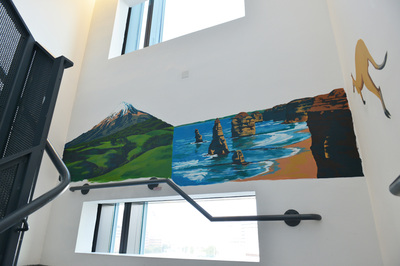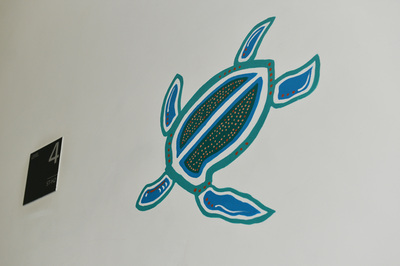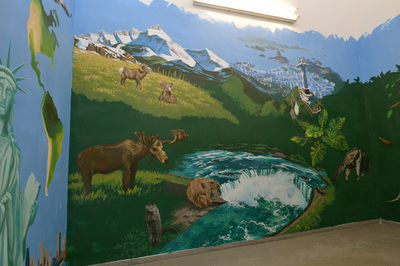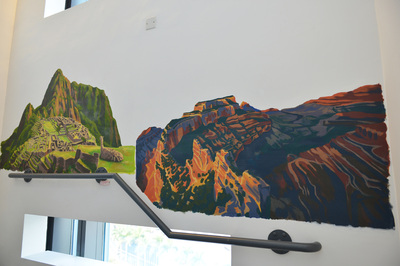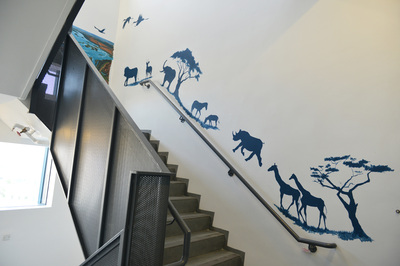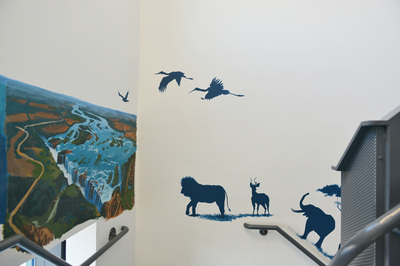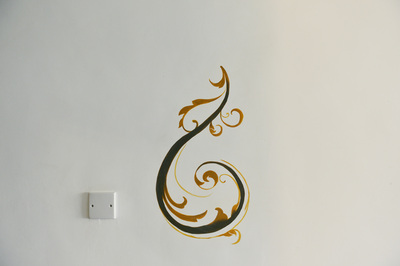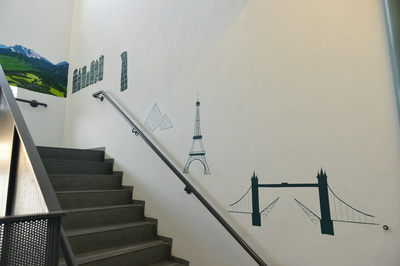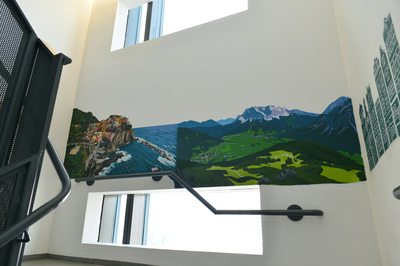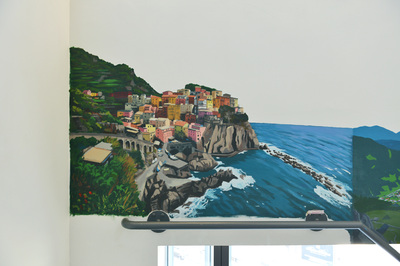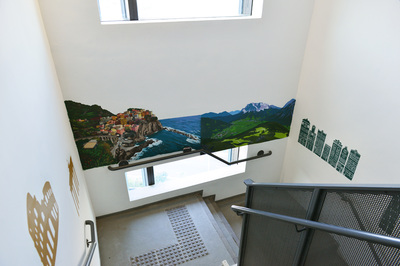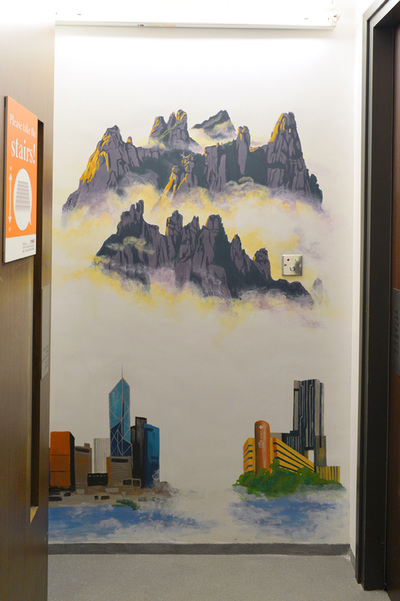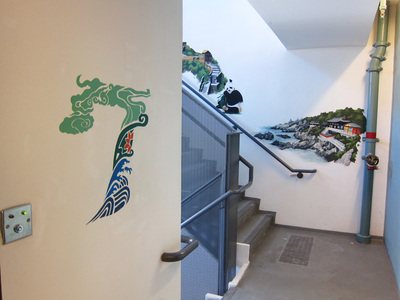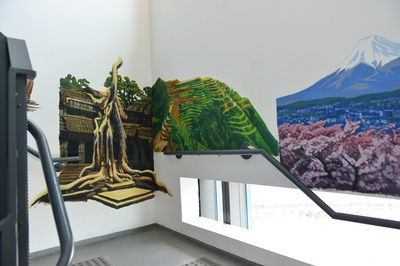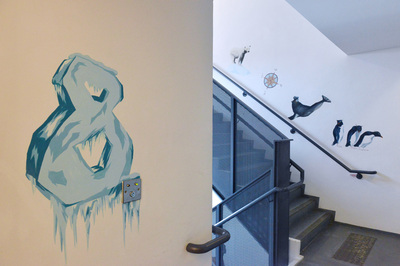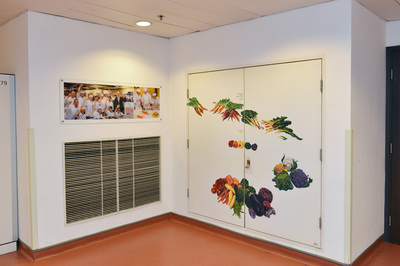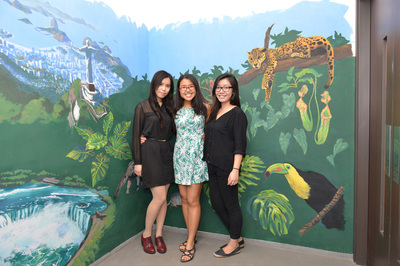Regions of the World, 2014
The School of Tourism and Hotel Management (SHTM), Hong Kong PolyTechnic University (PolyU)
The original aim of this mural project was to liven up the otherwise blank stairwell of the SHTM to encourage the use of the staircase over the elevators, and to create art that would also educate viewers about regions of the world.
The project began with 6 floors of stairwell, each with a geographical region. From Australia and Oceania (3/F), North and South America (4/F), Africa (5/F), Europe (6/F), Asia (7/F), to the North and South Poles (8/F). The project then extended to the basement food labs to create a series about different types of food, celebrating fruits and vegetables from different regions and of different colors. I was also asked to design a mural for the Samsung Lab of Hospitality Technology.
Article about the project on PolyU's SHTM website.
The project began with 6 floors of stairwell, each with a geographical region. From Australia and Oceania (3/F), North and South America (4/F), Africa (5/F), Europe (6/F), Asia (7/F), to the North and South Poles (8/F). The project then extended to the basement food labs to create a series about different types of food, celebrating fruits and vegetables from different regions and of different colors. I was also asked to design a mural for the Samsung Lab of Hospitality Technology.
Article about the project on PolyU's SHTM website.
Stairway Mural - Regions of the World
Walking 10 flights of stairs is never fun. Unless you get to travel while doing it.
The aim of this project was provide life to otherwise blank walls, taking you on a visual journey around the globe while improving your health, helping the environment, and even saving time!
Education and Nature
In this series of stairway murals, each floor was designed around a geographical region, from Australia and Oceania (3/F), North and South America (4/F), Africa (5/F), Europe (6/F), Asia (7/F), to the North and South Poles (8/F). It is of course impossible to create a thorough representation of each country or culture. So during the design process, I strived to capture what I see as the distinctive qualities of each region, as well as find a balance between very recognisable landmarks and less known aspects that can serve to educate viewers. As an art and nature-lover, I included not only the top tourist symbols, but also local flora and fauna, landscapes, art forms, and cuisine unique to each region. For example, we think of Africa as having deserts and savanna grasslands with little vegetation, but do we know that South Africa is home to more than 22 000 indigenous seed plants and home of 10% of the world’s flowering species?
I am drawn to the vast natural landscapes, hence including places like Victoria Falls (Zambia/Zimbabwe), the Grand Canyon (USA) and the Mt Fuji (Japan) is a must. But as an advocate for environmental conservation, some of these places are chosen for more than their picturesque appearance. For instance, the Great Barrier Reef (Northeast of Australia) is the world’s largest coral reef system, and supports a diversity of life, including many vulnerable or endangered species. However, it is facing severe environmental threats from climate change, pollution and fishing, and is in risk of disappearing if governments do not commit themselves to lessen these environmental impacts.
The South American rain forests are continually destroyed for lumber, mass agriculture and urban development. Its continual disappearance is resulting in the destruction of tribal cultures and loss of plant and animal species that can be used for medicinal purposes, and expediting climate change to a disastrous level through emissions and the lack of forests to absorb the carbon dioxide in the atmosphere.
Also included in my murals are ruins from ancient cultures such as East Island, Angkor Wat (Cambodia), the Maya (Chichen Itza, Mexico) and the Incas (Machu Picchu, Peru). These are societies that have collapsed due to over-use and devastation of the environment that then led to conflict (in the case of Easter, Angkor, Maya), or invasions from the West (Inca). I believe that it is crucial for us to study and learn from these past societies and histories so that we can build a future where the world can sustain itself in peace and harmony.
Art and Culture
As an artist, I also willfully included elements of visual and performing arts, culinary arts and local architecture in my designs. One of the staircases is dedicated to Maori (New Zealand) and Aboriginal (Australia) art and designs. For Africa, I used Egyptian-style plants designs, included musical instruments like the bongolo drums and the kalimba, and painted masks from the Dogon people in Mali. I depicted a village of the latter, as well as one of people from the Nuba Mountains in Sudan. I believe in being inclusive and tolerant of cultures and religions, so while Rio de Janeiro features a prominent statue of Christ, for Asia I chose the Haedong Yonggungsa in Busan, Korea, which a Buddist temple.
Art and culture is also of course very prominent in the design for Europe. Torn about which elements to include, I tried to find single visual elements that can represent several cultures and art forms. Carmen as a flamenco dancer combines a Spanish dance with an opera written by the French composer Bizet, who based it on a novel written by Prosper Mérimée. "The Thinker" is a renowned sculpture by French sculptor Rodin, but is an image that often used to allude to philosophy. Written by Russian composer Tchaikovsky, the music from Swan Lake is one of the most recognized pieces of classical music; it is also one of the most performed ballets around the world.
As a foodie and passionate cook, I don’t think a representation of culture can be complete without the local cuisine! That is why the Europe mural contains everything from Spanish paella to Dutch stroopwafels to Eastern European borsch soup. I apologies if you get too hungry walking through the 6/F! I also included some signature dishes of the Americas on 4/F, such as Mexican Tacos and the Boston lobster.
Space and Design
A major element I have to consider during the design process is space. At the entrance to the staircases, between the fire doors, the walls are wide and continuous, hence I can make large compositions that include a variety of elements. Having a flow is key to creating a dynamic image. Usually these have a spacial progression that corresponds to either the ecosystems, geography or terrain of the region depicted. The African design was very much determined by soil color, from yellow desert to reddish sands, to grey dry soils, to the grassy savanna. The American design progressed left to right from North to South America. Visually it makes sense to put the Rocky Mountains and Rio’s mountainous landscape high above, then everything else below. The elements in Europe very roughly correspond to the geographical locations of its countries, although it is more important to create a balanced composition, hence the landscapes tend to be at the top.
The staircases themselves are more limited in terms of space. One would usually not pause to look for too long, and it is impossible for us to physically paint on the staircase beyond the limit of our hand. Thus the elements on the staircases tend to be single architectural landmarks or animals. With landscapes being my passion and specialty, I decided to devote all the staircase landings to various landscape.
Asia is one of the continents that was largely constrained by the space - the walls between the fire doors are very small, hence most of the painting was done in the staircase. For the former space, a huge consideration goes into what one sees as they open the first door from the corridor. In the latter, since there are lots of countries to represent in limited space, I concentrated on elements that are very unique to Asia. For example, these include tall mountains with rugged rock formations, terraced rice fields, temples, the bengal tiger and Asian elephants (different from those found in Africa).
Conclusion
Overall this project was a huge challenge, given its scope and the time constraints. Spending all day standing up, climbing up and down or sitting on the floor while your arm is suspended in the air doing very detailed and precise work is actually extremely physically demanding! But it is all worth it, because this is one of the most exciting and fulfilling projects I have ever undertaken. I would like give my heart-felt thanks to SHTM for providing me with this opportunity. I deeply appreciate your commitment in educating students beyond the textbook, encouraging them to experience culture, develop taste, and think outside the box. White walls don’t have to remain white! They can be transformed into something people can connect to.
Last but not least, I am grateful for my two assistants Michelle Bok and Lindsay Qian. They played a crucial role in completion of this project! Thank you!
The aim of this project was provide life to otherwise blank walls, taking you on a visual journey around the globe while improving your health, helping the environment, and even saving time!
Education and Nature
In this series of stairway murals, each floor was designed around a geographical region, from Australia and Oceania (3/F), North and South America (4/F), Africa (5/F), Europe (6/F), Asia (7/F), to the North and South Poles (8/F). It is of course impossible to create a thorough representation of each country or culture. So during the design process, I strived to capture what I see as the distinctive qualities of each region, as well as find a balance between very recognisable landmarks and less known aspects that can serve to educate viewers. As an art and nature-lover, I included not only the top tourist symbols, but also local flora and fauna, landscapes, art forms, and cuisine unique to each region. For example, we think of Africa as having deserts and savanna grasslands with little vegetation, but do we know that South Africa is home to more than 22 000 indigenous seed plants and home of 10% of the world’s flowering species?
I am drawn to the vast natural landscapes, hence including places like Victoria Falls (Zambia/Zimbabwe), the Grand Canyon (USA) and the Mt Fuji (Japan) is a must. But as an advocate for environmental conservation, some of these places are chosen for more than their picturesque appearance. For instance, the Great Barrier Reef (Northeast of Australia) is the world’s largest coral reef system, and supports a diversity of life, including many vulnerable or endangered species. However, it is facing severe environmental threats from climate change, pollution and fishing, and is in risk of disappearing if governments do not commit themselves to lessen these environmental impacts.
The South American rain forests are continually destroyed for lumber, mass agriculture and urban development. Its continual disappearance is resulting in the destruction of tribal cultures and loss of plant and animal species that can be used for medicinal purposes, and expediting climate change to a disastrous level through emissions and the lack of forests to absorb the carbon dioxide in the atmosphere.
Also included in my murals are ruins from ancient cultures such as East Island, Angkor Wat (Cambodia), the Maya (Chichen Itza, Mexico) and the Incas (Machu Picchu, Peru). These are societies that have collapsed due to over-use and devastation of the environment that then led to conflict (in the case of Easter, Angkor, Maya), or invasions from the West (Inca). I believe that it is crucial for us to study and learn from these past societies and histories so that we can build a future where the world can sustain itself in peace and harmony.
Art and Culture
As an artist, I also willfully included elements of visual and performing arts, culinary arts and local architecture in my designs. One of the staircases is dedicated to Maori (New Zealand) and Aboriginal (Australia) art and designs. For Africa, I used Egyptian-style plants designs, included musical instruments like the bongolo drums and the kalimba, and painted masks from the Dogon people in Mali. I depicted a village of the latter, as well as one of people from the Nuba Mountains in Sudan. I believe in being inclusive and tolerant of cultures and religions, so while Rio de Janeiro features a prominent statue of Christ, for Asia I chose the Haedong Yonggungsa in Busan, Korea, which a Buddist temple.
Art and culture is also of course very prominent in the design for Europe. Torn about which elements to include, I tried to find single visual elements that can represent several cultures and art forms. Carmen as a flamenco dancer combines a Spanish dance with an opera written by the French composer Bizet, who based it on a novel written by Prosper Mérimée. "The Thinker" is a renowned sculpture by French sculptor Rodin, but is an image that often used to allude to philosophy. Written by Russian composer Tchaikovsky, the music from Swan Lake is one of the most recognized pieces of classical music; it is also one of the most performed ballets around the world.
As a foodie and passionate cook, I don’t think a representation of culture can be complete without the local cuisine! That is why the Europe mural contains everything from Spanish paella to Dutch stroopwafels to Eastern European borsch soup. I apologies if you get too hungry walking through the 6/F! I also included some signature dishes of the Americas on 4/F, such as Mexican Tacos and the Boston lobster.
Space and Design
A major element I have to consider during the design process is space. At the entrance to the staircases, between the fire doors, the walls are wide and continuous, hence I can make large compositions that include a variety of elements. Having a flow is key to creating a dynamic image. Usually these have a spacial progression that corresponds to either the ecosystems, geography or terrain of the region depicted. The African design was very much determined by soil color, from yellow desert to reddish sands, to grey dry soils, to the grassy savanna. The American design progressed left to right from North to South America. Visually it makes sense to put the Rocky Mountains and Rio’s mountainous landscape high above, then everything else below. The elements in Europe very roughly correspond to the geographical locations of its countries, although it is more important to create a balanced composition, hence the landscapes tend to be at the top.
The staircases themselves are more limited in terms of space. One would usually not pause to look for too long, and it is impossible for us to physically paint on the staircase beyond the limit of our hand. Thus the elements on the staircases tend to be single architectural landmarks or animals. With landscapes being my passion and specialty, I decided to devote all the staircase landings to various landscape.
Asia is one of the continents that was largely constrained by the space - the walls between the fire doors are very small, hence most of the painting was done in the staircase. For the former space, a huge consideration goes into what one sees as they open the first door from the corridor. In the latter, since there are lots of countries to represent in limited space, I concentrated on elements that are very unique to Asia. For example, these include tall mountains with rugged rock formations, terraced rice fields, temples, the bengal tiger and Asian elephants (different from those found in Africa).
Conclusion
Overall this project was a huge challenge, given its scope and the time constraints. Spending all day standing up, climbing up and down or sitting on the floor while your arm is suspended in the air doing very detailed and precise work is actually extremely physically demanding! But it is all worth it, because this is one of the most exciting and fulfilling projects I have ever undertaken. I would like give my heart-felt thanks to SHTM for providing me with this opportunity. I deeply appreciate your commitment in educating students beyond the textbook, encouraging them to experience culture, develop taste, and think outside the box. White walls don’t have to remain white! They can be transformed into something people can connect to.
Last but not least, I am grateful for my two assistants Michelle Bok and Lindsay Qian. They played a crucial role in completion of this project! Thank you!








